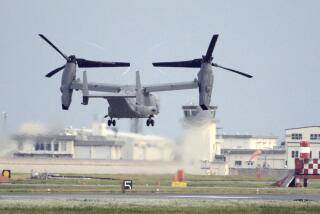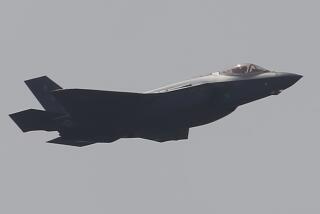After 60 years, Alaska glacier gives up wreckage from 1952 crash
- Share via
The shifting of an Alaskan glacier has released wreckage and frozen remains from what is believed to be a military cargo plane that crashed 60 years ago, killing everyone aboard, military officials said Thursday. This week, for the first time, the military was able to complete a recovery mission for the missing plane.
Officials believe the wreckage is that of a C-124 Globemaster that crashed Nov. 22, 1952, near Mt. Gannett. The U.S. Air Force plane went down near Alaska’s so-called graveyard of airplanes, where jagged mountains make landing particularly difficult.
A Black Hawk helicopter’s crew discovered the yellow spars of debris on June 10, during a routine training mission for the Alaska Army National Guard. The wreckage was found on Colony Glacier, a pitted glacier riddled with crevasses 40 miles northeast of Anchorage, nearly 14 miles from where the plane first crashed.
PHOTOS: Military plane is recovered from glacier
“The glacier essentially held these things in a capsule,” said Elizabeth Feeney, a spokeswoman for the Joint POW/MIA Accounting Command, a military group that recovers and identifies long-dead soldiers. “Many of the things that we get back are easily identifiable.”
The military has shipped the remains to labs in Hawaii, where experts will analyze what is expected to be bones from some of the 41 passengers and 11 crew members, Army Capt. Jamie Dobson said.
The wreck was first identified days after the crash by a member of the Fairbanks Civil Air Patrol and a member of the 10th Air Rescue Squadron, according to an Associated Press report from 1952.
After returning from the site, the civil air patrol member -- University of Alaska President Terris Moore -- told reporters that the plane “obviously was flying at full speed” when it struck Mt. Gannett. The plane appeared to have slid down the cliffs and exploded, spewing wreckage across several acres.
At the time, the tail was intact enough for identification. Moore said he found blood on a blanket and the “sickly-sweet smell of death.”
The wreck quickly sank deeper into the glacier. When a rescue team hiked there soon after, it found nothing.
Among the missing was Isaac Anderson, who left behind a young widow and a toddler son. His granddaughter researched the crash for 12 years, but said she was told by the military that recovering remains would be too involved and too expensive.
“I’m overwhelmed,” Tonja Anderson of Tampa, Fla., told the Associated Press on Wednesday. “If they can bring me one bone of my grandfather or his dog tag, that would be closure for me.”
Officials are moving to have the area legally protected, Dobson said, to preserve any more remains or artifacts that may emerge from the glacier.
ALSO:
Alien invasion? That’s OK with most Americans
Colorado scene: From aerial photos, hope amid wildfires
A space telescope to thwart deadly asteroids: Donations needed
Follow Laura on Twitter. Email: [email protected]
More to Read
Sign up for Essential California
The most important California stories and recommendations in your inbox every morning.
You may occasionally receive promotional content from the Los Angeles Times.











